How does branding affect customer behaviour?
08/06/2025
Branding
Explore the powerful link between branding and customer behavior—and how the right brand strategy can turn browsers into lifelong buyers.
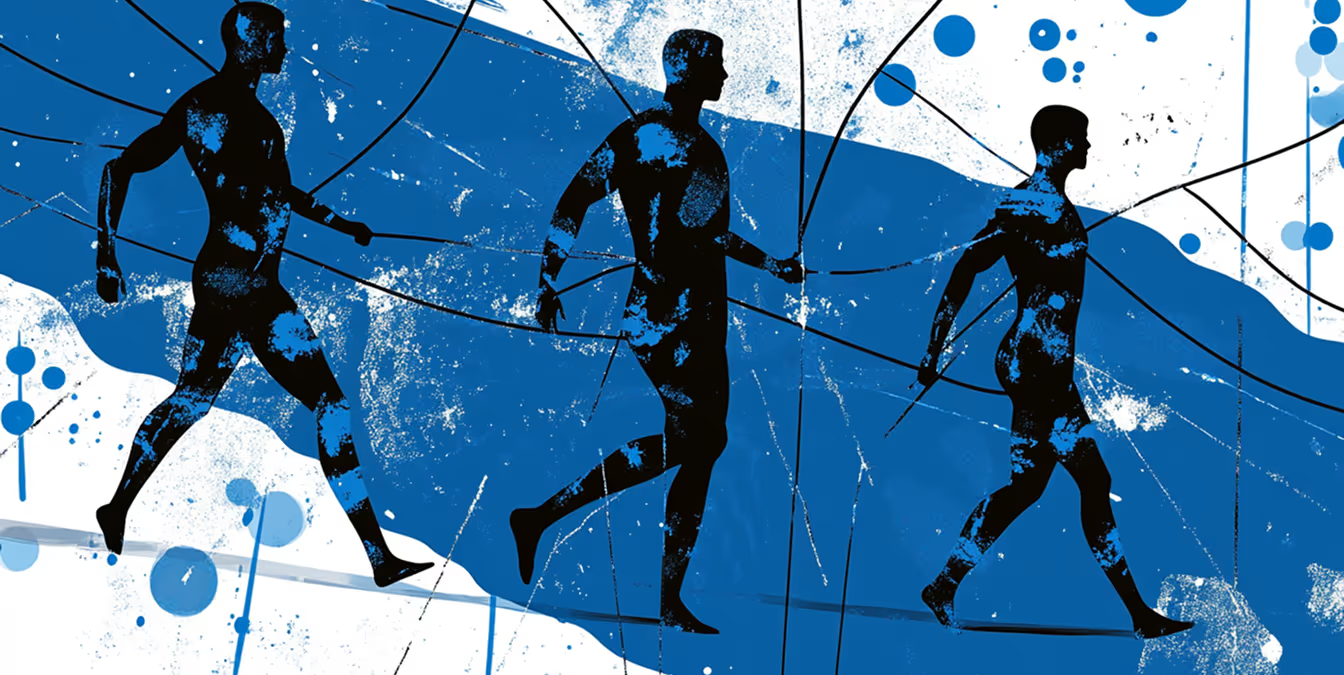
Through branding, companies are able to create an emotional bond with their customers that goes beyond just product features or prices. If done right, brands can become so much more than something you buy – they can be something you believe in and identify with.
.png)


What is a brand?



Branding is probably the most powerful tool for businesses in today's world — yet, few people know what it is or how to take care of it.
The idea of a brand has been around for thousands of years, so why is it so important now?
Well, we are no longer in a mass production era and customers now have control, deciding what to buy and from whom.
The old method of choosing products was to compare features and benefits.
However, these basic comparisons don't work anymore — people make decisions based on more profound symbolic attributes.
After reading this article, you will understand why you need to build a strong brand for your business and the steps to do so.
We’ll also share some essential ideas about customer behaviour that will help you understand why customers do what they do.
Let's start the journey with a clear definition of a brand, and to do that, we must begin by clarifying what a brand isn't.
Many people think a brand is a logo, however, a logo is simply a symbol that helps people identify a business.
While a logo is a very useful tool for companies, it is not a brand.
A brand is not a corporate identity.
An identity is how businesses present themselves to the public and helps to bring consistency in terms of the companies' look and feel, but it is not the brand.
People think a brand is a product.
You have probably heard (or said), "I will buy this brand," or "I don't know which brand to choose," or "I like this brand." However, people are really talking about products or services, not brands.
Others say a brand is a promise companies make to customers, which is partially true because a brand ends up acting as a promise, however, that is still not what it is.
The truth is that a brand is a result; as Marty Neumeier says, a brand is a gut feeling about a product, service, or company.
It is a gut feeling because we all are emotional and intuitive, not rational, as we like to say.
How do customers get the gut feeling?
Customers take every piece of communication you send out to them and they make something out of it — they create meaning.
So, in other words, you are creating millions of brands because each person will feel a little bit different about you and your company.
You can think of a brand as your reputation and each person from your audience will feel different about what that reputation is.
Your job is to communicate in a way that can positively affect people to think the best of your company.
And remember, you can influence what people think, but you can’t control it at all.
To create the reputation you want, you need branding.
Why you should care about branding
First, let’s define branding.
With some inspiration from the book The Brand Gap, the definition we come up with is the following: Branding is the process of creating a humanized business identity to interact with your audience and influence their perception and gut feeling.
We can’t control what people think, but branding allows us to shape their perceptions.
But why should you care about branding? The following are three crucial reasons:
- Because people have too many choices and not enough time
- Because most companies offer similar quality and features
- Because humans base their buying choices on trust
People won’t create a relationship with your logo or your products. People will, however, build a relationship with the human side of your company.
Branding is existential stuff and you don't have a company without a brand.
As customers, we know that many organizations just go and copy each others' features and benefits.
Companies do that because they know that customers will buy anything from anyone (at least that was the case in the past).
However, business competition has become very high and it has allowed customers to gain control — they can now choose whoever they think is the best option.
So, why should consumers choose you? Because they are emotionally connected with you and they trust you.
Differentiation between Marketing, Advertising and Branding
Businesses must understand that marketing, advertising, and branding are not the same.
Marketing and advertising have short-term goals; they care about the present and use strategies to get things done now.
On the other hand, branding is the company's lifestyle.
Its purpose is to actively shape the consumer's perception of your company, product, or service — it is an everyday activity that never ends.
The following is a visual representation from The Brand Gap of the differences between these three concepts.

Marketing helps you say what you offer,
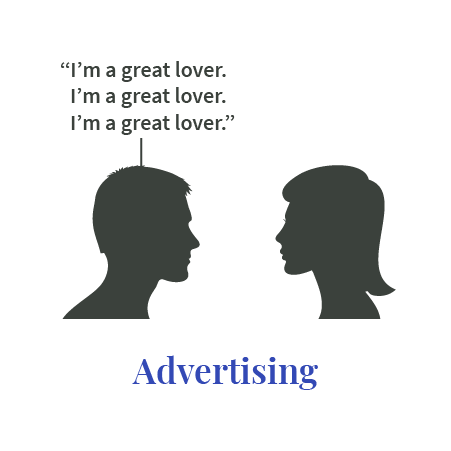
Advertising helps you say what you offer… over and over.
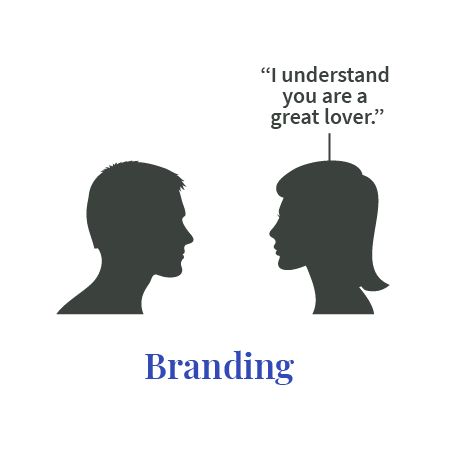
Branding helps THEM understand what you offer.
Customers create your brand.
You can guide them towards what you want your brand to represent, but if you keep telling them what they have to think, they will reject you every time. So remember the following about branding:

How customers perceive your brand
The basic definition of perception is "the ability to see, hear, or become aware of something through the senses." The key phrase?
Become aware. Over 90% of the time, people are on autopilot; they do the same activities repeatedly by memory, without thinking.
Why is this important?
Because you have to get people out of autopilot and make them conscious about you.
Once you get their attention, their perception will depend on the feelings and emotions they have after interacting with your business.
And as we mentioned earlier, you don’t have control over how people perceive you, but you can influence it.
Brand perception
Brand perception is what customers feel and believe your products or services represent, which is vital because what businesses think they communicate might differ from what customers understand.
You can shape this perception by creating a solid and compelling personality for your business that represents the mission and vision.
After developing a personality, you have to ensure that every piece of communication you send out conveys your business' core values.
How can you shape customers’ perceptions?
Although many sites talk about influencing people's perception by focusing on human senses, such as visual, auditory, olfactory, taste and even emotional.
We want to prioritize online perception as it is more important than ever before.
The first step to shaping customers' perceptions is being relevant.
It doesn't matter what you do or how you do it, if what you share with your audience is not important to them, you lose.
Check out this complete digital content marketing strategy guide to better understand how to create content that resonates with your audience.
If you are trying to be relevant, you need to understand your audience’s values and beliefs.
Check out this short section about creating a buyer persona that will help you identify insights and not indicators.
When you understand your customers and their values, you can start thinking about your communication strategy.
Although you should be relevant in many different areas, we will discuss four of them as must-haves for companies when shaping customer perceptions.
1) Content
Any type of information you share with your audience is content, whether it be video, image, audio, or text.
Some examples of content are social media posts, blog posts, articles, infographics, company videos, podcasts, and more.
If you identified the right buyer persona and their emotional values, you could produce specific information directed to them.
Here are seven principles that you need to know to create the perfect content for your brand that is visually attractive:
1- Contrast

2- Space

3- People/faces

4- Movement



5- Breaking rules

6- Directional cues

7- Person’s name/their own face

When these principles are applied correctly and you send out the right message, you can influence people’s perceptions about your company by changing their focus.
2) Value propositions
A value proposition is a promise of value to be delivered. It is the main reason a prospect should listen to you.
When creating a value proposition, you need to explain how your product or service is solving customers' problems (relevancy), how you’re delivering specific benefits (value), and how you’re different from your competition (unique).
There is no right or wrong. Sometimes, the most unexpected phrases resonate more with people.
Here is a simple formula that you can follow to create a strong value proposition.
Headline: Clearly state the final benefit you are offering in one short sentence. Your headline has to be your attention grabber (the most important part of your value proposition).
Sub-headline or two to three sentence paragraphs: This should explain what you offer, whom it is for, and why it is useful.
Three bullet points: List the most relevant critical benefits of what you have to offer.
Visuals: Images communicate better and faster than words. Use them to show your offer and connect with people emotionally. Images should always reinforce your messages.
3) Implicit communication
Explicit communication is verbal, open, unambiguous, precise, and clear.
On the other hand, implicit communication is all the information conveyed in a nonverbal, hidden, covert, unexplained, and sometimes not obvious way.
Implicit messages are less clear and are usually associated with culture or life experiences.
However, implicit communication can be very powerful for businesses when used correctly.
So, how can you use implicit messages for your brand?
You can use colours, images with deep meanings, facial expressions, backgrounds, layouts, body language, and anything else that gives people specific clues to make them feel/believe something about your business.
Examples:
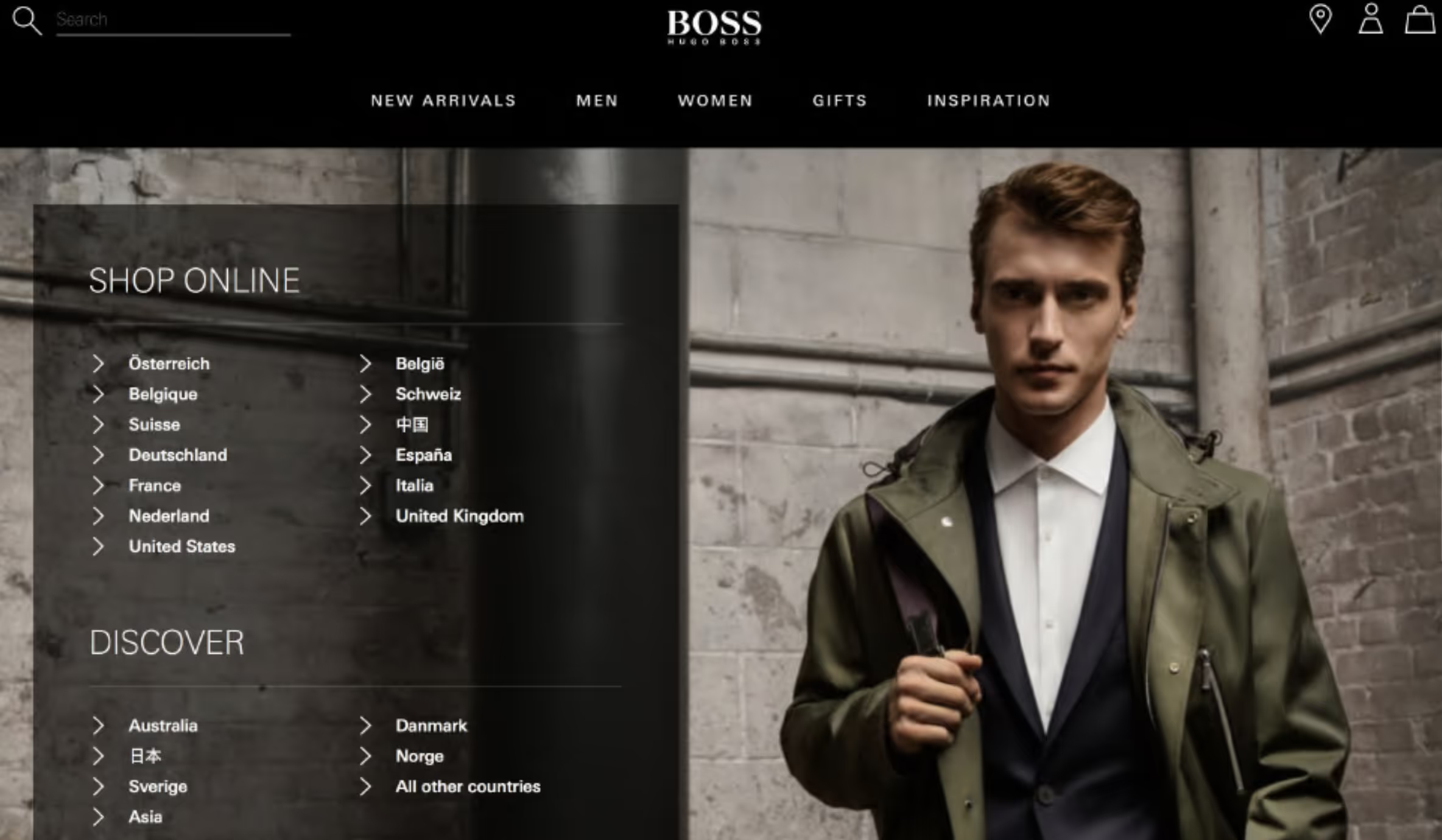
Can you perceive the implicit messages?
Let’s analyze the following image from CXL training explaining some of the implicit messages we found.

Boss is a pricey brand that focuses on conveying the feeling of status and prestige, and everything in this image tries to communicate that.
Usually, expensive products have a minimalist design; people with unfriendly faces express confidence and independence; black is associated with sophistication, power, and elegance.
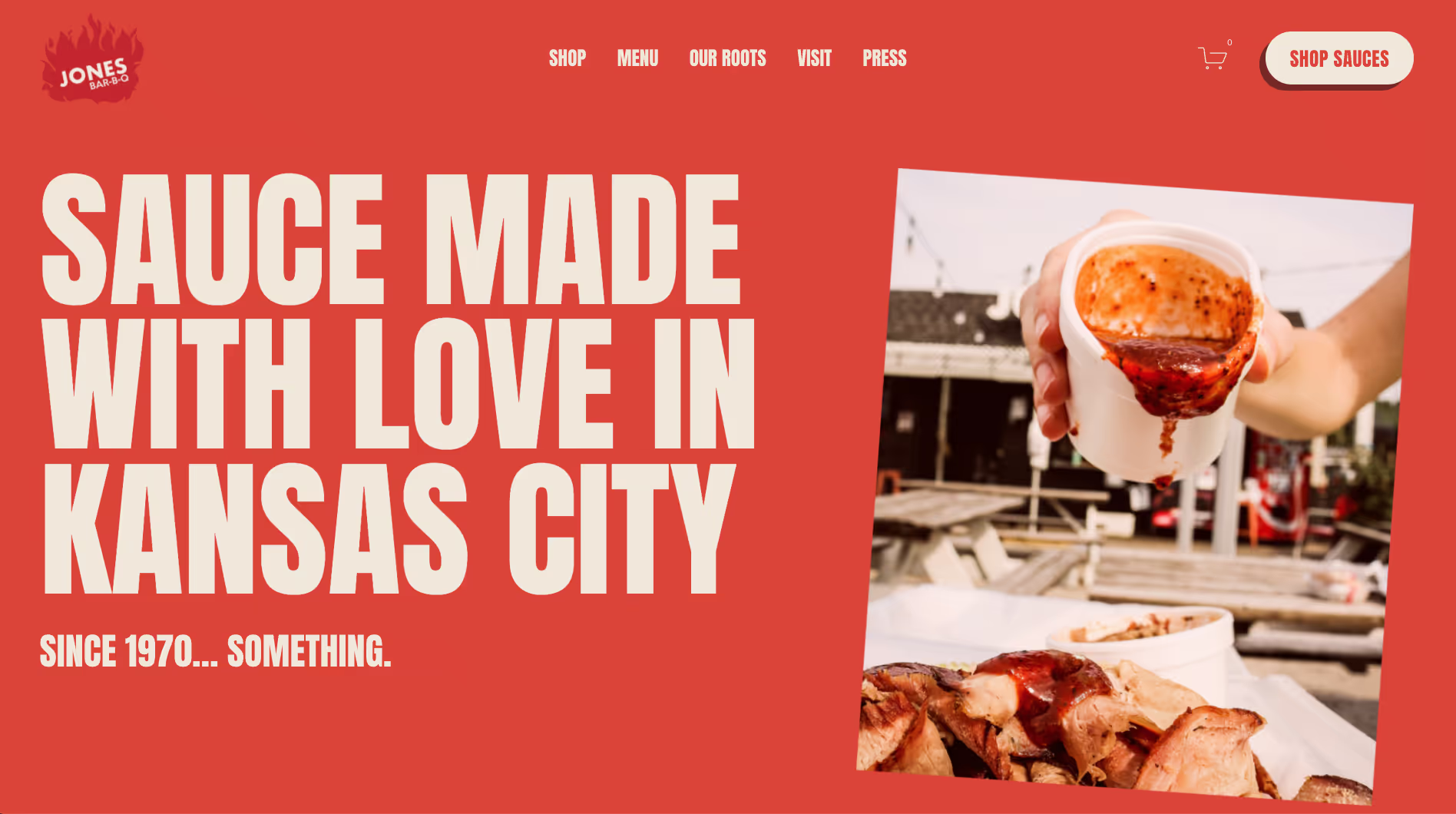
What about this image from Jones Bar-B-Q, a completely different feeling, right?
The sauce in the plastic cup means homemade, fresh, direct from the source.
And the colour red, of course, means hot, fire, and spicy; red also activates appetite.
All these messages from both examples are well thought out; image selection can never be random — you must control the explicit and implicit communication.
4) Emotional relevance (resonance)
Remember, for your content to resonate with the right people, you must put all your energy into defining their needs and pain points as precisely as possible.
Here are some questions about your audience that you should answer:
- What are their informational needs?
- What are their values?
- Why would they care about your products or services?
- What are their pain points?
- What is their personality?
- What does their average day look like?
As Seth Godin says, "when you speak to everyone, you speak to no one." Businesses make this mistake every day, thinking that the more people they speak to, the more opportunities they will have. Unfortunately, it doesn't work like that anymore.
People want to connect with businesses, have profound and meaningful interactions, support a cause, have two-way communication, and feel that companies care about them.
Check out this strategy to identify core values in your buyer persona. You can also download our free template from there.
Why do you need a strong brand?












Having a strong brand will help you differentiate your business from the competition, and more importantly, it will allow you to connect with people emotionally.
In today’s world, it doesn’t matter where companies are located; they can sell from anywhere at any time which is why you need to be different.
Here are some other reasons why standing out is critical:
- Because there are around 400 million businesses in the world
- Because everyone sells the same things
- Because people have less time
- Because people support businesses that stand for something
- Because people buy based on emotions
- Because you have to be relevant
- Because otherwise, you will be ignored
A business with a strong brand has a personality, a voice, meaningful core messages, a reason for existence, values, an identity and more. The benefits you will get by taking care of your brand are more significant than you think and here’s the proof.

Internal benefits of having a brand
1) Brands create culture, culture creates brands: Corporate culture refers to shared values, attitudes, behaviours, and practices that represent an organization. It is all about the way people interact with one another and how they face daily business activities as a whole. On the other hand, a brand is a result that is translated as people's gut feeling about your company, product, or service — it is about emotions and how customers perceive your business.
If the business culture is about respect, creativity, and care, it is logical that those same values will build a business reputation (brand) that customers will feel and appreciate. On the other hand, a brand can also influence culture. If you position your company as a creative, friendly, and customer-focused organization, you know exactly the people you need to create that culture, which takes us to our next point.
2) Brands improve recruitment: When you have a strong brand and understand your businesses' core values and beliefs, you know exactly what kind of people you need to keep those values alive. More importantly, when your business has a clear "why" or reason for existence, people who feel the same way will feel attracted to your organization, including potential employees.
3) Brands provide direction: When organizations know what they stand for and what their dreams and aspirations are, they understand exactly where to go and why they are going there — the brand serves as a North Star. Having a clear vision provides direction and certainty and makes the decision process within the organization more straightforward and efficient. Finally, when there is a purpose, a ‘why’, people feel empowered and encouraged to take the next step, allowing the organization to move faster.
4) Brands give a sense of purpose: Extraordinary things can happen when a company has a clear direction and a clear sense of purpose. Having a common goal gives everyone a sense of belonging, a reason bigger than themselves to achieve the desired future. A brand gives every organization member a meaning behind what they do; they believe their job will help (or hurt) others, motivating people to work better and harder.
A brand gives everyone a reason to get out of bed every morning and go to work. When people do things that they care about, passion flourishes.
As Simon Sinek says: "Working hard for something we don't care about is called stress. Working hard for something we love is called passion."
5) Brands increase job satisfaction: When people work for a strongly branded company with a culture that supports and stands for the same things they do, employees will be more satisfied with their job and have greater pride in their work. In addition, working for a company with a solid and positive reputation makes everyone feel engaged, enjoy what they do, and develop a sense of fulfillment.
Many companies forget that stakeholders are not just clients, but also employees. You must be aware that people who work for your company are the first line of communication with clients. So when you take care of your people, they will take care of your clients as a result.
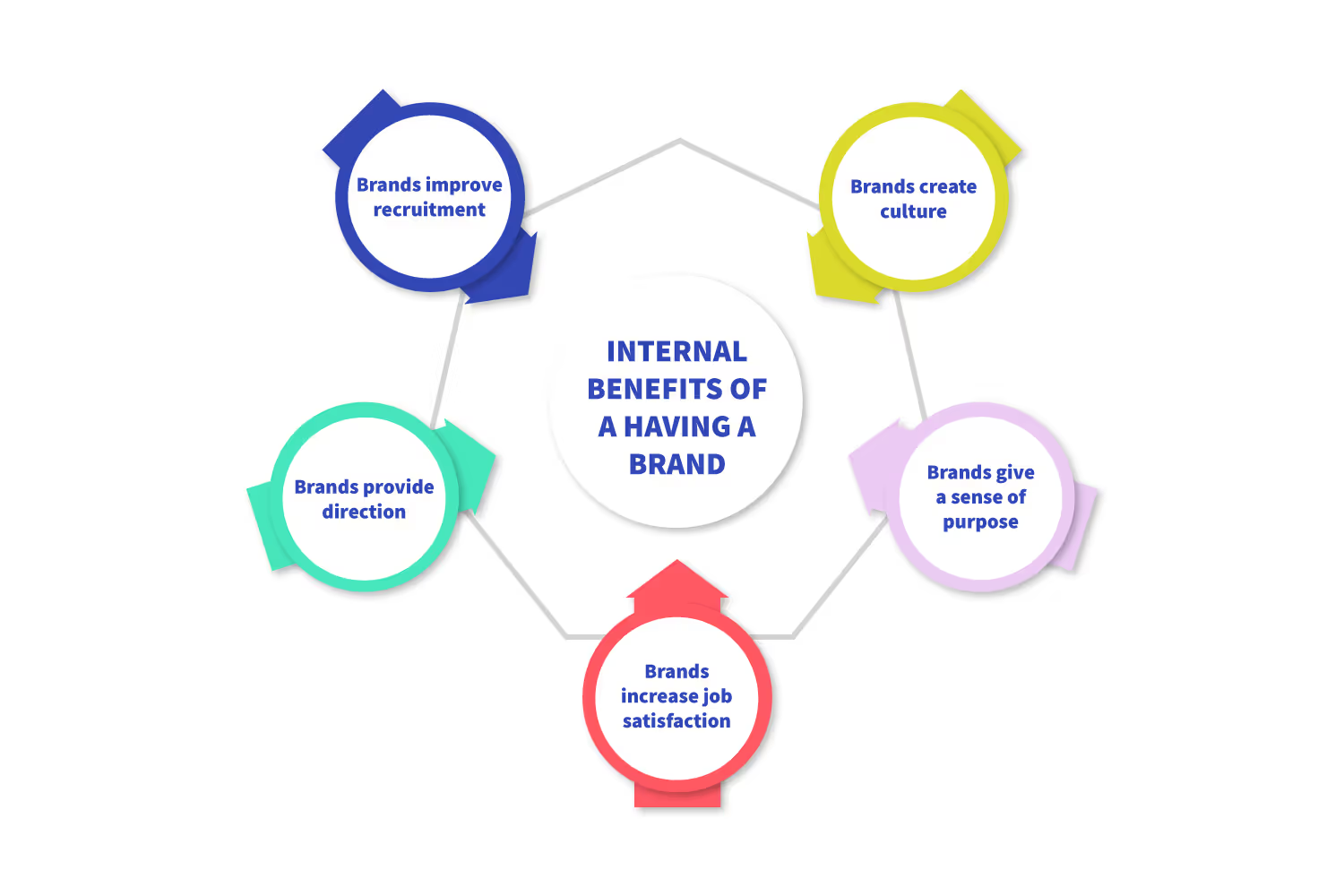
External benefits of having a brand
1) Brands increase recognition: Company recognition is associated with what people say, think, and believe about your company. When customers can accurately identify your mission and vision — what you stand for — you have achieved a certain level of recognition. Many sites mention the logo as the central concept when talking about recognition. However, as we know, a logo is a symbol that helps people connect an image (the logo) to the "soul" of the company (the brand).
Put simply, you want to be recognized for what you do, who you are, and what you stand for, not for how nice your shirt is. Good branding agencies first create a brand personality, define its why, then start thinking about the logo. Unfortunately, many people have things the other way around.
2) Brands create differentiation: As we have mentioned, the competition is exceptionally high, and many businesses sell the same things in the same way. A brand's purpose is to make your business unique and stand out from the crowd. Companies with a strong brand have distinctive values, beliefs, and look and feel, making it nearly impossible to find two same organizations.
If 100 brands look and feel the same way, but you have a strong brand that sets you apart from the masses, you will inevitably generate more customer attraction.
3) A brand shows you stand for something: Although we have mentioned this in multiple sections of this article, it is crucial to understand why we strongly believe in the importance of a business’ purpose:
- Having a cause translates into a stronger reputation, brand affinity, and bottom-line results.
- Business owners must understand the significant, positive relationship between a solid purpose and success.
- Studies have validated these understandings.
These are some insights from the "strength of purpose" study, which reveals that when consumers think a brand has a strong purpose, they are:
- 4 times more likely to purchase from the company
- 6 times more likely to protect the company in the event of a misstep or public criticism
- 4.5 times more likely to champion the company and recommend it to friends and family
- 4.1 times more likely to trust the company
4) Brands generate new businesses: One of the most significant sources of new businesses is word of mouth, and as we just mentioned, customers are 4.5 times more likely to champion a company with a strong purpose (brand) and recommend it to friends and family.
When customers are delighted with your service, trust increases, and they will share their experience with everyone else. The results? More quality business for your organization.
5) Brands increase loyalty: Many people think that interactions build loyalty, that the more you interact with customers, the more loyal they will be. Unfortunately, this statement is not true. Instead, shared values are what build relationships and loyalty. A shared value means that customers and companies have the same vision and aspirations about how things should be.
For example, Pedigree Dog Food believes that every dog deserves a loving home; Nike believes that if you have a body, you are an athlete; Apple believes in thinking differently. So, whoever has the same values and beliefs as these companies are more likely to become a loyal customer.
6) Brands create emotional connections: People make decisions based on emotions and justify them with logic. We’ve heard this phrase many times, so why don't we try to apply it? People don't buy products or services; they buy new versions of themselves. They buy feelings and emotions. The same happens with companies; people choose companies based on emotions and how those companies will make THEM look in front of others.
Try it yourself, think about why you would choose one company over the other:
- Coke or Pepsi?
- Playstation or Xbox?
- Apple or PC?
- iPhone or Android?
- Dunkin’ Donuts or Starbucks?
- McDonald’s or Burger King?
You will have an instinctive preference for one brand in each pairing, which is not rational — it is emotional.
However, you will justify your decision logically after making your choice.
Companies with solid brands look for meaningful connections.
They don't stop when the business/financial transaction is done — they aspire to generate engagement and delight consumers.

Want to learn more about brand platforms, Brand Strategy and Brand Identity? Keep reading!
If you need help with your companies brand strategy and identity, contact us for a free custom quote.
Branding and customer behaviour

Big corporations spend billions of dollars studying customer behaviour because they know that understanding people is key to thriving in today's business.
Learning everything about psychology, neuromarketing, or behavioural science would take you a long time, but it is essential to have some foundational knowledge about these critical topics.
This section will introduce you to some psychological principles that will boost your brand's influence and help you guide your customers in making the right decisions.
What is customer behaviour?
Customer behaviour is the series of actions or patterns that customers follow when deciding to buy products or services.
These behaviours change depending on multiple variables, such as life experiences, age, environment, beliefs, knowledge, memories, mood, and much more.
Also, the way people behave depends on the customer journey and the medium.
For example, people act differently when recognizing needs, searching for information, making a decision, and especially when interacting online or face-to-face.
Why should you know about customer behaviour?
Understanding what motivates customers is vital for companies because it helps recognize consumers' expectations and how they satisfy their needs, allowing you to act accordingly.
The most crucial advantage to understanding customer behaviour is that it allows you to create and market your company more effectively.
When you understand how customers behave, you spend the money where it matters, you connect deeply with the audience, and the information you share has a meaning and purpose — when you understand customers, nothing is by chance.
What affects customer behaviour?
Everything in the world is constantly shaping customer perception and, as a result, their behaviour.
More importantly, the way we were brought up, our life experiences, our beliefs and other internal factors play a crucial role in our decision-making process.
You might be wondering, how can this help my business?
And the truth is that this information is all you need to create a successful business.
Remember, customers create your brand, not you.
So, being aware of how customers make decisions allows you to create a brand that can connect with them emotionally and build an ever-lasting relationship.
When you understand people's behaviour, you can say the right thing at the right time.
As a result, you can make customers feel understood, heard, and encouraged, inspiring them to talk about your brand, generating deals and word of mouth.
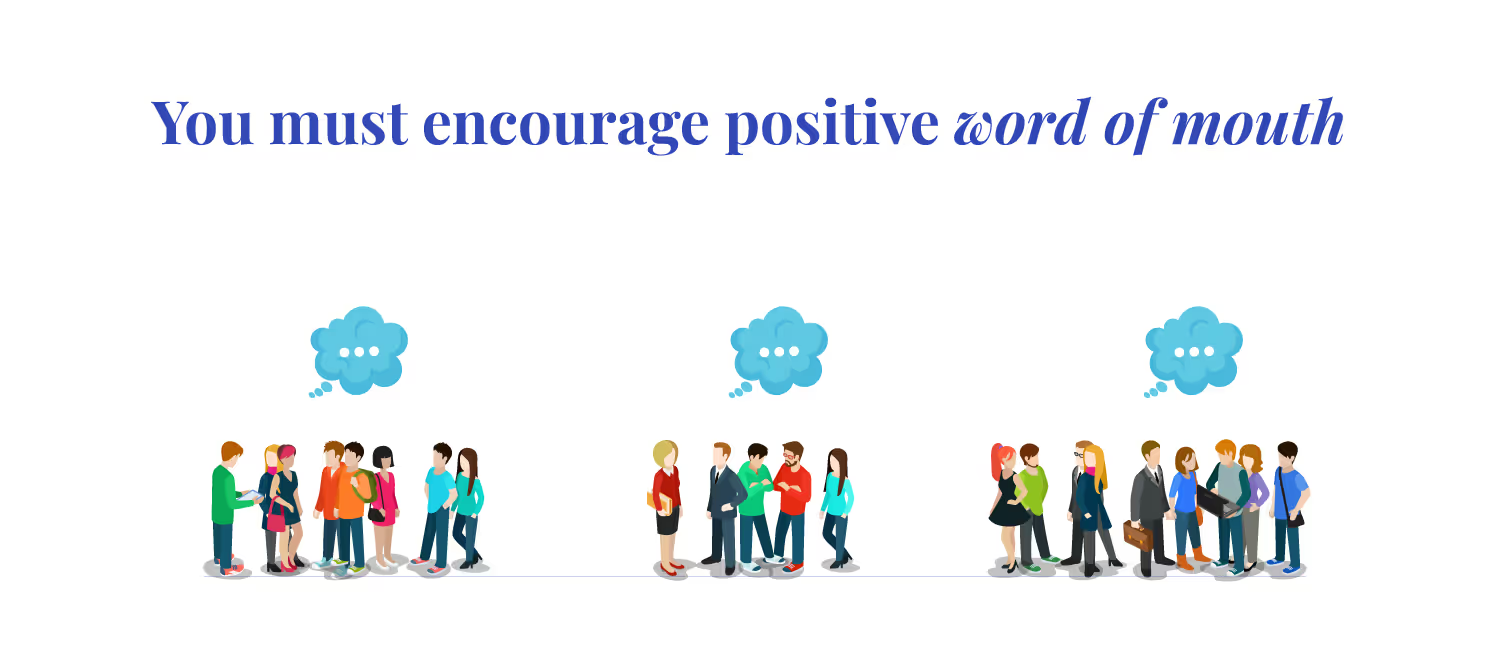
Let's talk about the five factors that influence customer behaviour.
1) Psychological factors
Human psychology has become one of the foundations of branding because it helps companies understand at a deep level why people do what they do and what they are looking for.
The following are some psychological factors that you must be aware of and use to position your brand.
- Motivation: Motivation is a crucial factor that affects customer behaviour because it is associated with the most basic human needs. The most popular theory that will help you understand this is Maslow's hierarchy of needs. This theory identifies physiological needs, safety needs, social needs, esteem needs, and self-actualization needs where people try to fulfill their most basic needs first (physiological), working their way to the most complex (self-actualization).
- Perception: Remember that perception is what customers feel and believe your products or services represent. So, when people see something about your company, they form an idea/image that will dictate how they feel about your company. You can influence your brand perception by creating a compelling identity, defining a clear set of values, and having a purpose in addition to everything we’ve discussed in previous sections.
- Learning: When customers buy products, they learn about them through experience. However, when people haven't experienced anything similar to what you offer, they seek external resources to get that knowledge. Some of the most popular ways to learn about something is by asking friends and family, reading reviews, watching videos, etc. People need to understand what they are buying before they commit to a purchase. Your brand needs to be perceived as easy to understand and talk about so that people associate it with simplicity with trustworthiness.
- Attitudes and beliefs: Everything people believe will affect their behaviour both consciously and subconsciously. The way customers see life will dictate absolutely everything they ever purchase. A strong brand will help you connect with people who believe what you believe, which is the ideal scenario for your business. When people see life the same way as you or your company, they will support you and protect you against anything.
2) Social factors
Humans are social beings and we are constantly interacting with others. Some people are like us, some are not.
However, the key to social factors is that humans continuously compare themselves with others and seek social acceptance.
Therefore, whoever customers interact with shapes their behaviour, for better or for worse.
This is where branding becomes more potent because when your brand has a positive perception, everyone will want to be part of it.
- Family: Depending on the type of relationship we have with family members, their actions towards some brands will affect our own behaviour. Customers develop an inclination or aversion towards products by seeing their families using those products. For example, if your family goes to a specific restaurant and they have been doing so for a long time, you will likely end up going to the same place (or something similar), which is called familiarity.
- Reference groups: These are groups of people with whom customers associate themselves. The members will usually have similar purchase patterns, behaviour, and have an influence on each other. It is essential to highlight that liking and admiration have a significant role in this idea of the reference group — people tend to be influenced more by people they like and admire.
- Roles and status: People tend to behave differently depending on their position in society. If somebody is in a high position, their buying behaviour will be strongly affected by their status. For example, a Chief Executive Officer will buy according to their status and how they want to be seen. On the opposite side, an employee in the same company will probably buy from somewhere completely different. Depending on how you brand your company is how people will see you. You control, through branding, whether your message will resonate with people who care about status, comfort, creativity, love, etc.
3) Cultural factors
Our values and beliefs are often shaped by our environment and the community we belong to.
For example, people from South America will behave entirely differently from those from Asia.
South Americans will probably jump and hug you to say hello, whereas Asians will respectfully say hi from one meter away.
Having a brand creates a common culture that people can feel like they belong to, no matter where they are from.
Here are some cultural factors.
- Culture: Cultural factors are strong influencers of customer behaviour. Here we find basic values, wants, preferences, needs, perceptions, and even behaviours obtained through observing family members and other important people in customers' lives.
- Subculture: These are small groups among the cultural group. Usually, people from subcultures have a stronger and more specific set of values and beliefs. The groups can be created by people from different religions, nationalities or geographies.
- Social class: Whether we like it or not, society is segmented by social classes. Social class is associated with customer occupation, background, profession, education, residence location, and more. Since our society follows a hierarchical structure, people aspire to climb the social ladder, hoping to find status and respect and actively controlling their behaviour.
4) Personal factors
Although social, psychological, and cultural factors constantly shape and adjust customer behaviour, personal factors can be decisive when thinking about how people behave.
These are unique, internal beliefs of how life should be.
The following are some of these factors.
- Age: This is one of the most fundamental differences in customer behaviour. Purchasing decisions of teenagers, middle-aged people, and the elderly are dramatically different. For example, a teenager might be interested in video games and having fun. In contrast, middle-aged people might seek stability by getting a house, and older people might not even look for things for themselves, but rather for their grandchildren.
- When positioning your brand, you have to make sure that you know your audience's age and adapt your message to resonate with them specifically.
- Income: The amount of money people have also impacts their behaviour. The higher the income, the higher the purchasing power. When people have more money, they get access to more luxurious items, whereas people with less would go for more affordable products. So you need to choose if your brand is for people with a lot of money or whether you want to prioritize customer accessibility by offering lower prices.
- Occupation: People tend to buy things that are appropriate for their professions. For example, a business person would probably choose different clothes than an artist or musician. In addition, people's jobs usually expose them to certain kinds of people, shaping their behaviour.
- Lifestyle: The most critical behaviour creator is how people live and what they do daily. For example, if customers follow a healthy lifestyle, every single decision they make will be based on that way of living — prioritizing products and services that represent them the best.
5) Economic factors:
These factors are self-explanatory and associated with the money people have, which we’ve already discussed.
What you will find in this category is personal income, family income, consumer credit, liquid assets, savings, consumer credits, etc.
After analyzing all these factors, you can now understand the importance of having a brand and not just a business.
A brand will give your company a personality that you will be able to use to interact with your audience and try to shape customers' perceptions legitimately.
Next, we will introduce you to the most famous psychological principles that companies use to persuade customers.
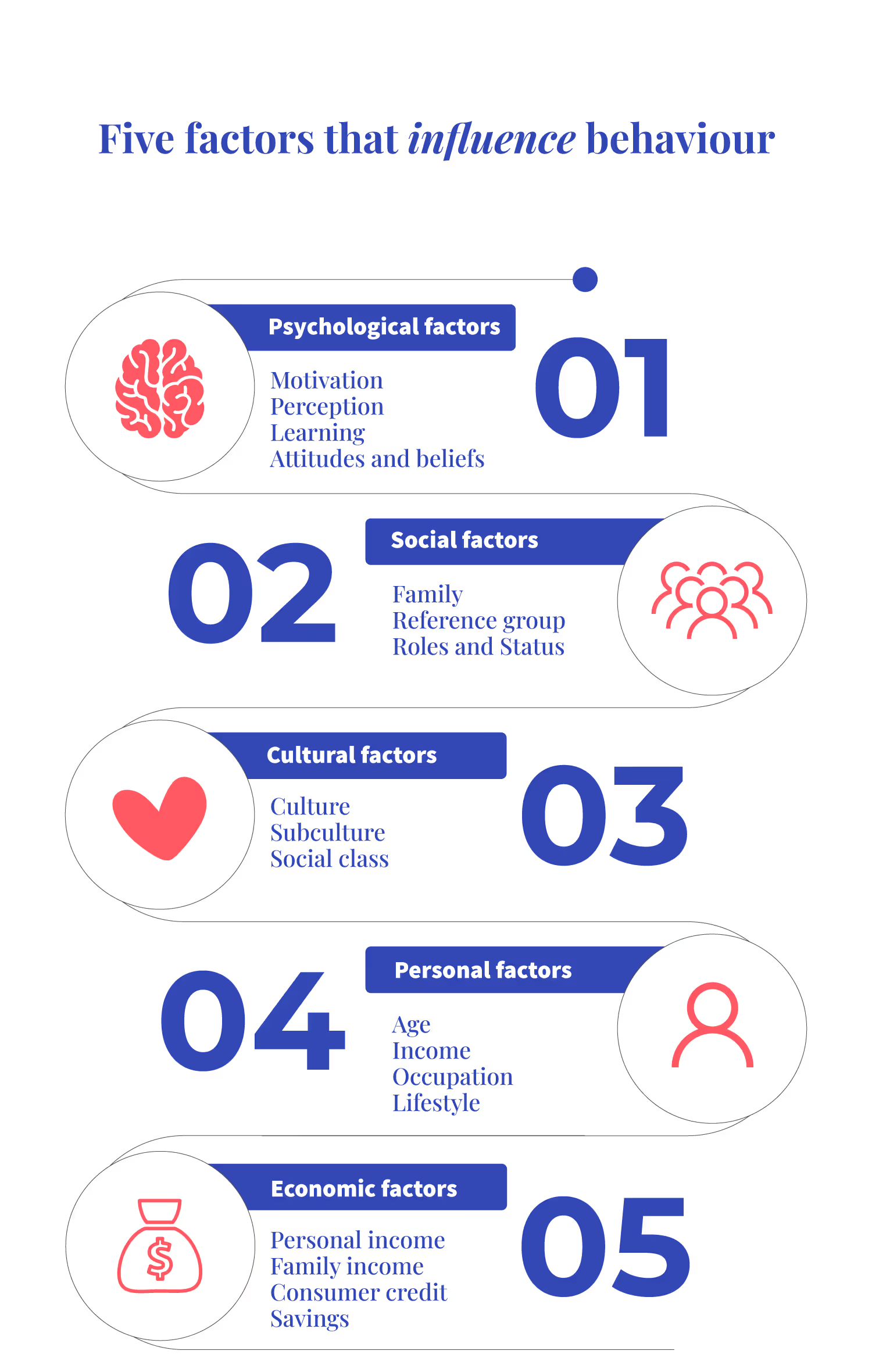
How to influence behaviour
In 1984, Dr. Robert B. Cialdini wrote Influence: The Psychology of Persuasion.
Since then, companies worldwide have used his principles and applied them in all of their marketing and branding strategies.
These "old" principles are still powerful because even though everything has changed and been updated, one thing has stayed the same for hundreds of thousands of years — the way humans think and behave.
Here are the most famous principles that you can use today to create a strong brand and captivate your customers.
- Reciprocity: This principle of persuasion states that humans are wired to want to return favours and pay back their debts. The core of reciprocity says that when you provide value and care about others, they will care about you when you ask for something. However, you should never give with the expectation of receiving something in return; that goes entirely against this principle. Customers are smart and they can sense when somebody is doing something for their own interest.When using this principle, please remember the following:
- Don't expect anything in return
- Whatever you are providing must be helpful. You can't give away a free guide or Ebook that is outdated or looks terrible.
- Always give the best you have
- Practice this principle regularly
- Never think about what you have to gain; it is all about your customers
Always remember: "treat others as you wish to be treated."
- Commitment/consistency: Humans have a deep need to be seen as consistent. Once we publicly commit to something or someone, we are much more likely to deliver on that commitment. Businesses have used this by making people comply with a small request first, then asking for more significant actions.
- Have you ever seen something like this? This is an example of commitment from the website nutritioneering.
They basically ask you many questions, which might take around 3 - 5 mins to complete.
However, the longer you spend answering questions, the more committed you are.
So, in the end, when they ask for your email to get the results, you are much more likely to provide it because you already spent a “long” time completing the form.
- Social proof: Social proof is the most popular and widely used principle to influence behaviour. Cialdini defines it as "people doing what they observe others doing." This principle is based upon the idea of safety in numbers. For example, most travellers have followed the masses to the baggage claim — at least after their very first flights. Another common example is when you see one restaurant with a long line and another one that is empty. Which restaurant would you think is better? Most likely the one with the line — that is social proof.
- The following are some more examples that you are probably familiar with.
Authority: As humans, we tend to obey authority figures, sometimes even without question.
For example, we will gladly follow or obey people with names like “Dr. Sebastian” or other titles and even people wearing specific clothing or accessories, like a security vest.
Companies use athletes to promote fitness products, doctors for health-related websites, and well-known chefs for restaurants.
Even Kim Kardashian on a shoe store website is considered an authority.
We know that not everyone has the budget to pay a famous person to promote their products, however, you can use any doctor, athlete, or professional title and the results could be very similar.
The following image from Nngroup has 4 sections that use the principle of authority.
The first section is a hero image featuring an attorney, the second section shows three lawyers, the third section shows the logos of major news organizations and publications in which the firm was featured, and the last section shows a McAfee logo indicating that the site is secure.
Liking: According to Cialdini, liking someone increases the chances of being influenced by that individual.
Liking is based on sharing something similar with people you like.
Many companies use the "about us" page to share information about company members to help the organization connect with their audience.
PetRelocation does a fantastic job showing employees with their dogs because it creates a solid human, peer-to-peer connection with the audience. Doing this sends a message saying, "We like the same things that you like."
Scarcity: Humans tend to become more attracted to things that are limited or that might not be available for too much longer.
So you can use quantity or time to represent scarcity and say things like, “we have ten more left” or “just until Monday.” The best combination is when you have a limited product + competitors (other customers) that might be looking for the same thing.
For example, check out the following image showing Booking.com using multiple elements to represent scarcity (image from UX collective).
- Last booked for your dates 2 hours ago on our site
- Only 1 room left on our site!
- Expires in: 1 day
- 2 other people looked for your dates in the last 10 minutes
- Booked once for your dates in the last 24 hours on our site
How would you feel after reading all of those messages? You’d probably say something like, “Oh no, I need to book now!
There is one room left and many other people want it!” This feeling of urgency is what scarcity generates in people.
Remember, when people believe something is in short supply, they want it more.
Unity: Unity is based on shared identity.
When you meet somebody from the same university or school, the same soccer team, or somebody who plays the same sports, or reads the same things as you, you feel a connection of values and beliefs.
When applying this principle, people will say things internally like, "you are just like me; I trust and believe in you." Unity is about sharing identities.
How can you generate unity?
- Use specific and unique jargon: If your business is about CrossFit, for example, you would probably use words like WOD (workout of the day), AMRAP (as many reps as possible), T2B (toes to bar), and many more. Using specific phrases invokes pride and self-esteem — customers will say, "you are one of us and we want to buy from you."
- Convey exclusivity: You must make your company exclusive in terms of emotions and beliefs — make customers feel that if they want to be part of the tribe, they have to share specific values and principles.
- Define the “out-group”: Often, companies try to position themselves against whatever the status quo is in their industry. For example, Planet Fitness is against loud, aggressive bodybuilder types by putting up signs that say “judgment-free zone” and installing “lunk alarms” that go off if you drop your weights or make too much noise.
- Invoke family ties: For many people, family is their strongest tie.
- Co-creation or Sharing an Experience: Make people feel part of your business by asking for advice instead of opinions. When people give their advice, they are more likely to return because they feel they played a part in creating the new concept/idea. They feel more committed.
How branding affects customer behaviour: Key takeaways

- How branding affects consumer behaviour: Key takeaways
- People make decisions based on profound symbolic attributes. Today's world is not about features and benefits; it is about the emotions and gut feelings people get from interacting with your brand — you must shape your customers’ perceptions.
- The three crucial reasons why you need a brand are: Because people have too many choices and not enough time; because most companies offer similar quality and features; and because humans base their buying choices on trust. Remember that customers have control now and they choose what they FEEL is the best option.
- Customers’ perceptions will depend on their feelings and emotions after interacting with your business. And as we mentioned in this article, you don’t have control over how people perceive you, but you can influence it through your brand.
- You can influence customers’ perceptions by creating something relevant to them and, more importantly, by understanding your customers and their values. When you know what they stand for, you can create a message that will resonate with them.
- To make your brand stand out, you need to produce specific content, create a simple but relevant value proposition, control implicit communication, and connect emotionally with your audience.
- A business with a strong brand has a personality, a voice, meaningful core messages, a reason for existence, values and an identity that will set you apart from everyone else.
- Big corporations spend billions of dollars studying customer behaviour because they know that understanding people is key to thriving in today's business. Understanding human needs and applying the principles learned through this article will allow you to create the right content at the right time.
- A brand will help you create a business culture, improve your recruitment strategies, provide direction, have a sense of purpose and increase the job satisfaction of everyone who is part of the company.
- Lastly, brands are the stories people tell about you and your business behind your back. You can’t control those conversations, but you can influence them through your brand.

Sloane Avery
As entrepreneurs, they’ve built and scaled their own ventures from zero to millions. They’ve been in the trenches, navigating the chaos of high-growth phases, making the hard calls, and learning firsthand what actually moves the needle. That’s what makes us different—we don’t just “consult,” we know what it takes because we’ve done it ourselves.
Want to learn more about brand platform?
If you need help with your companies brand strategy and identity, contact us for a free custom quote.
We do great work. And get great results.
+2.3xIncrease in revenue YoY
+126%Increase in repurchase rate YoY

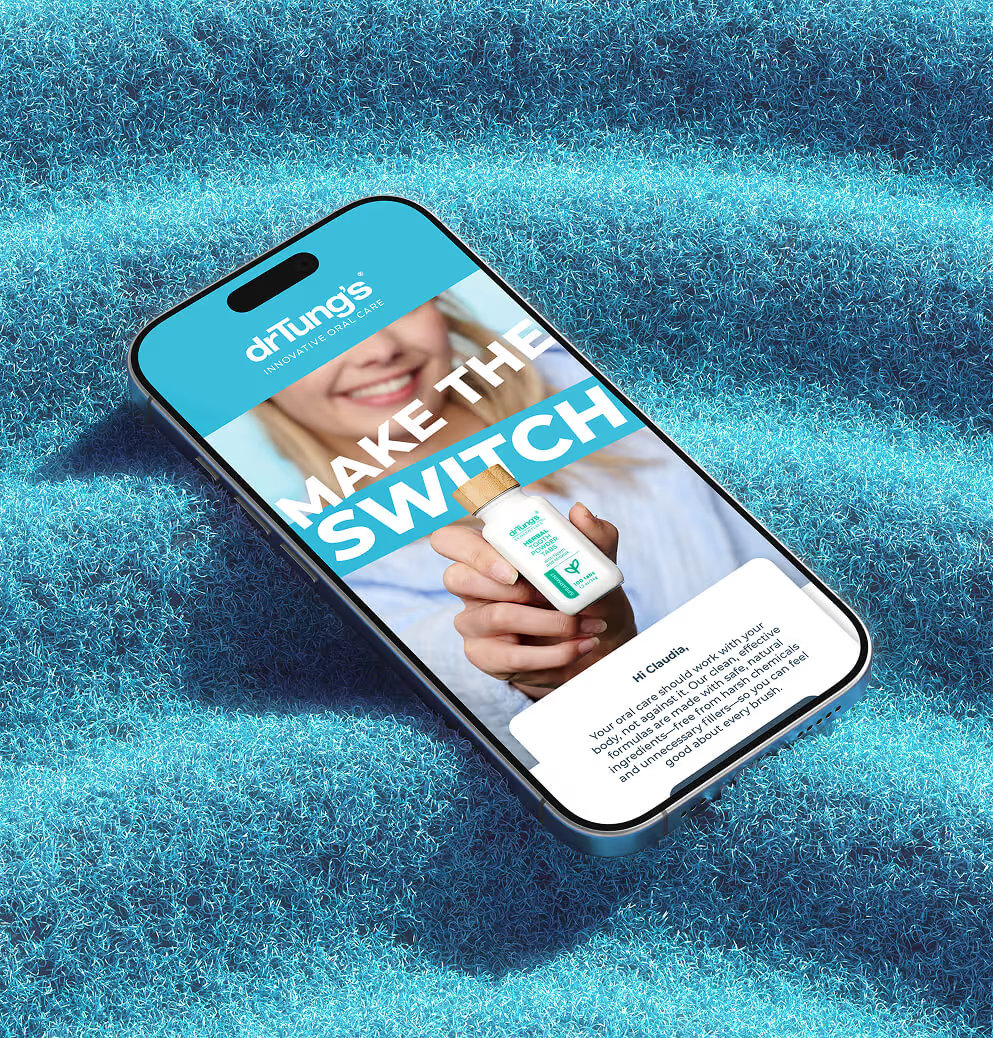






+93%Revenue growth in first 90 days
+144% Increase in attributed revenue


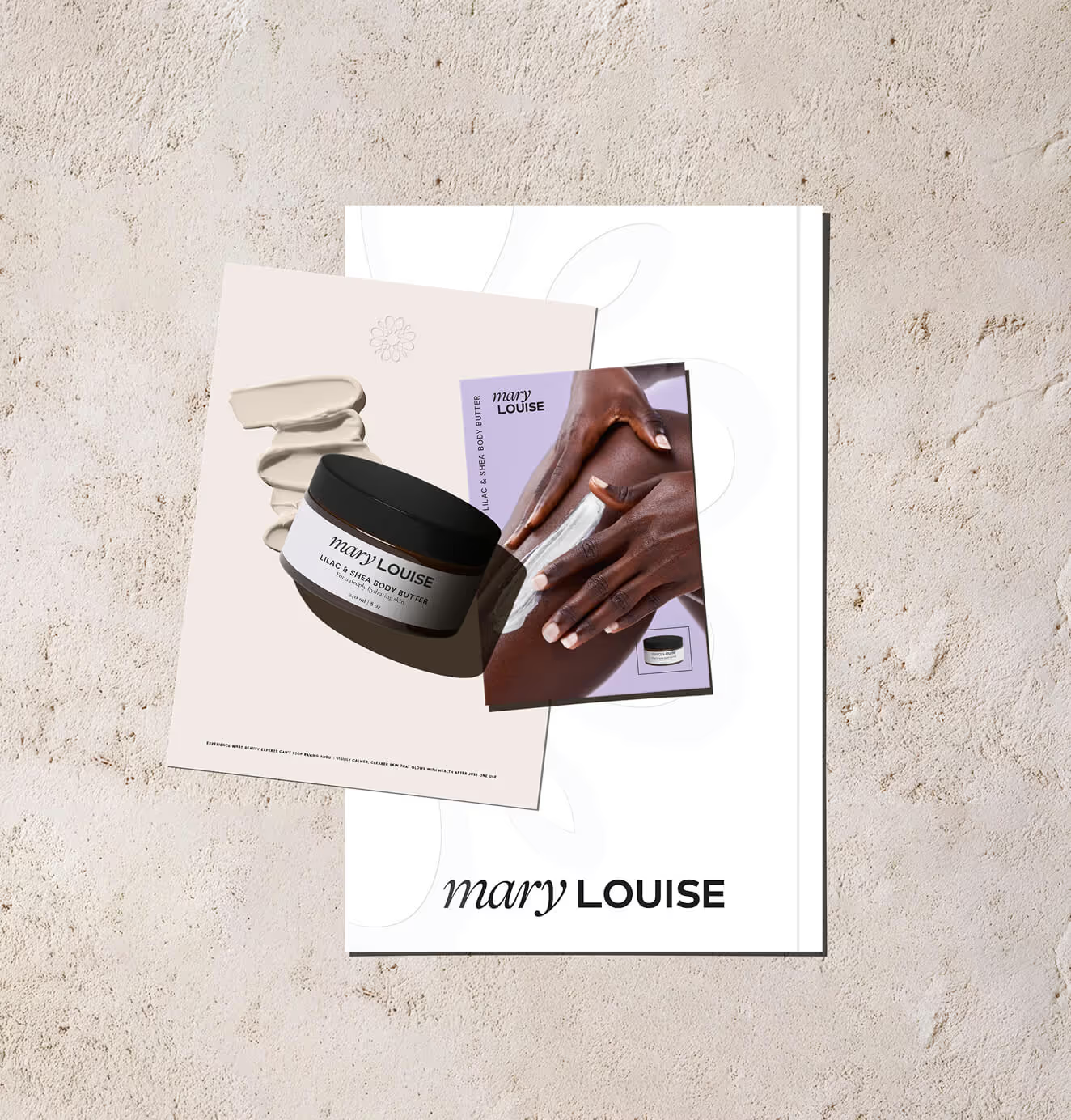





+91%Increase in conversion rate
+46%Increase in AOV



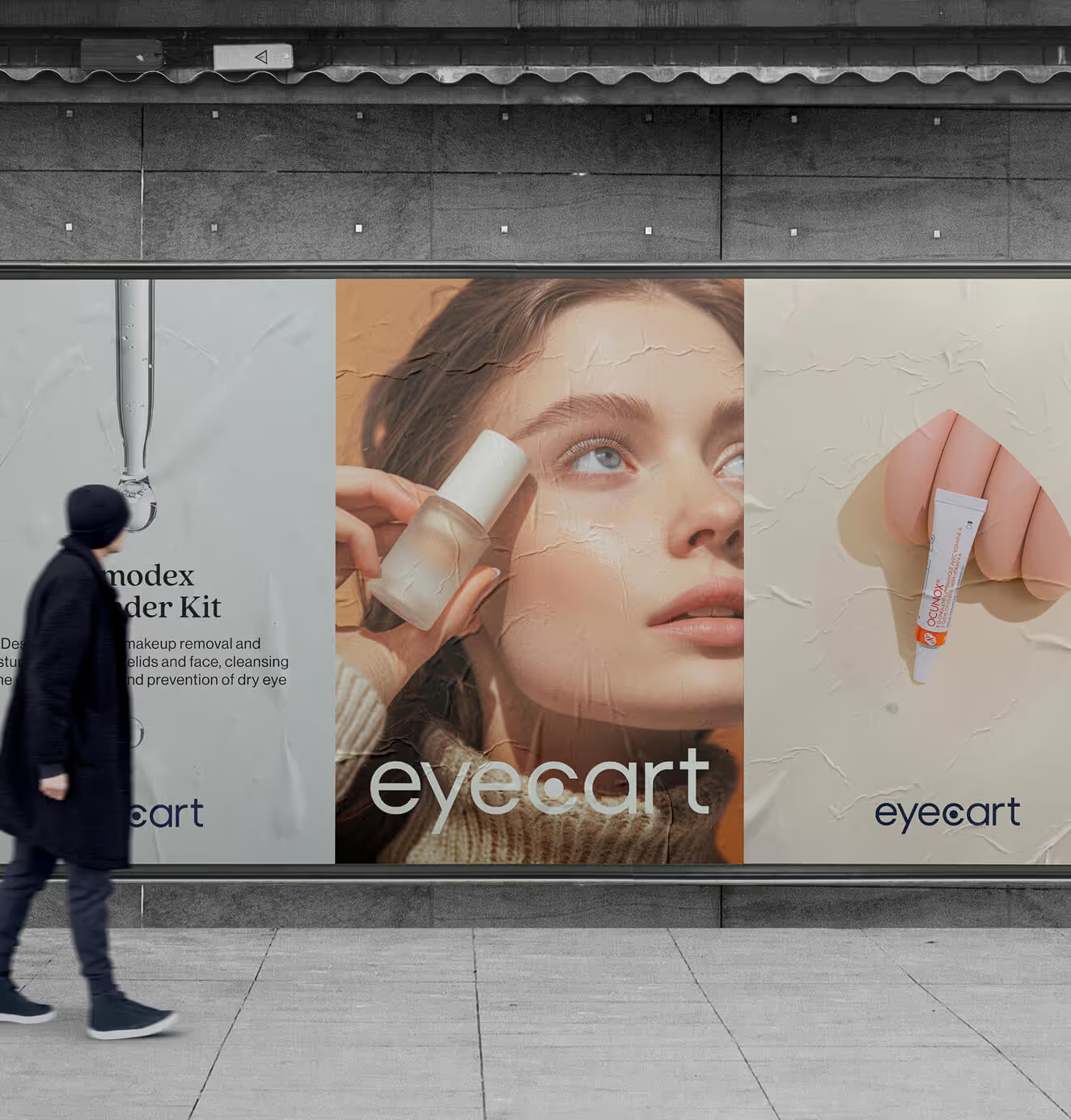




+200%Increase in conversion rate
+688%Increase in attributed revenue












